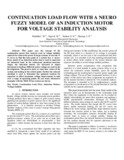Continuation load flow with a neuro fuzzy model of an induction motor for voltage stability analysis
| dc.contributor.author | Muriithi, Christopher M. | |
| dc.contributor.author | Ngoo, L.M. | |
| dc.contributor.author | Nyakoe, G.N. | |
| dc.contributor.author | Njoroge, S. N. | |
| dc.date.accessioned | 2017-09-07T09:40:21Z | |
| dc.date.available | 2017-09-07T09:40:21Z | |
| dc.date.issued | 2010 | |
| dc.identifier.uri | http://hdl.handle.net/123456789/2807 | |
| dc.description.abstract | This paper uses the concept of the continuation power flow analysis used in voltage stability Analysis for control the power in large systems. It uses the PV curves to find the knee point of a certain bus. A neuro fuzzy model of an induction motor load is used to represent an industrial load. In the subsequent predictor-corrector stages, the induction motors are increased to depict Increment in loading. Different motor ratings are used in the investigations. The process starts at some base values of the system and leading to the critical point. Further the reduced Jacobian is used to determine the optimum location for capacitor to affect maximum voltage improvement in total over a range of operating points. In case study, illustrative examples with the IEEE 30 bus system are shown. | en_US |
| dc.language.iso | en | en_US |
| dc.subject | Continuation Load Flow, | en_US |
| dc.subject | Induction Motors, | en_US |
| dc.subject | Voltage Stability | en_US |
| dc.title | Continuation load flow with a neuro fuzzy model of an induction motor for voltage stability analysis | en_US |
| dc.type | Technical Report | en_US |

